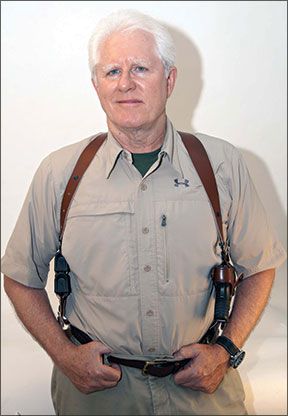When it comes to handgun concealment, perhaps the most colorful configuration is the shoulder holster. Shoulder holsters are not as popular in the real world as they are in old detective movies, but that has as much to do with contemporary style as it does with the cost of a good rig, especially when compared to a Kydex belt holster. People simply do not wear sport coats as much as they used to. But shoulder holsters do provide superior access when seated at a desk or behind the wheel of a car.

To learn more about shoulder holsters, we purchased four different models from the company that offers more designs than any other maker. Galco International (USGalco.com) began making gun leather in the late 1960s as the Famous Jackass Leather Company in Chicago, Illinois. Their most famous product was a shoulder holster referred to as the Jackass Rig worn by Don Johnson in the second season of the 1980s hit show Miami Vice. Later, Johnson’s character, Detective James “Sonny” Crockett, was fit with a new model from Galco, the Miami Classic. It was covered by a summer-weight sport jacket and sparked a trend in men’s fashion that some of us would like to forget.
To carry our full-size Springfield Armory 1911 45, we chose the $200 VHS vertical carry shoulder system with a vertical drop dual magazine pouch. To house our Springfield Armory XDM 3.8 9mm compact, we picked the $195 Miami Classic II with dual magazine pouch, offering horizontal open top access. For our Caspian 1911 Commander we bought a $165 Jackass Rig, also with a vertical drop dual magazine pouch. This design offered abbreviated coverage of the pistol’s top end but greater diagonal adjustment for the holster than the Miami Classic. For our Sig Sauer P239 we tested a $93 Classic Lite shoulder system with single vertical drop magazine pouch fashioned from center cut steer hide with a natural finish. The Classic Lite is the least expensive shoulder system that Galco makes.
Blocking the Holsters
The first step in assembling the Galco shoulder holster system was to “block” the holster bodies. Blocking is primarily a stretching process that forms the interior of the holster so that the gun may be fully inserted with the retaining strap closed. As directed by the manufacturer, we placed the gun into a plastic (freezer) bag and pushed it as far as we could into the holster body. During this process, we found that only the VHS vertical holster, which utilized a retention strap beneath the trigger guard, was able to fully accept the gun. Nevertheless, we followed the ritual of bagging the gun. According to Galco, it may only require an hour or so to stretch or block the leather. But we left it overnight anyway.
In the case of the Classic Light holster, our initial impression was that we had purchased the wrong holster. To fully insert the P239, we had to remove the tension screw completely. The next morning we performed part two of the blocking process on the Jackass and Miami Classic rigs. We loosened the tension screws and pushed the guns further into the holster bodies and closed the retention straps. Then we tightened the tension screws down again. We still weren’t able to replace the tension screw in the Classic Light holster, but we were able to affix the tension strap. At this point we thought that we wouldn’t be able to use the tension screw at all during the service life of the holster. This is important because the outer fitting of the tension component is a snap ring that also serves as the male fitting for the tie downs. The tie downs add a belt loop for added stability, but one holster, the VHS vertical model, was not fitted for connecting a tie down. In the case of the three remaining holsters, we found that the use of a tie down was optional. If the individual was able to wear the holster high and tight below the armpit, then a tie down may not be necessary. But if the wearer prefers a lower carry position, then using a tie down becomes essential to prevent the weapon from swinging back and forth.
The first step in attaching the holster and magazine pouches was to lay the straps out on a tabletop with the Galco logo on the back plate facing you. The holster and magazine pouches will be accessed with the hands moving across the body approximately toward the biceps muscle of the opposite arm. So when the holster is placed next to the straps, it should be on the left side for a right-hand shooter with the thumb break facing down. The straps were fed through the hanger beginning with the outside loop so that excess length of the straps will ride flush against the body. The loose ends were connected to the outer portion of the strap by a set of low-profile caps and screws. The screws were not necessarily weight bearing but were used to capture the excess length of strapping. The straps on each holster were long enough to accommodate chest sizes up to 52 inches. Rather than cut away any excess strapping, we used Velcro to keep the few loose ends we did end up with from getting in the way.
Due to different body types, there may be disagreement about which of the four holsters is best. But we did find several inescapable factors during the course of our evaluation. Here is what we learned.
Galco Classic Lite, $93
The Classic Light holster required an extra day of blocking, after which we were able to reinstall the tension device. In fact, we had to. Without it, the gun was falling far enough into the holster so that the thumb break was no longer properly supported. We surmised that the nature of the split leather was such that it had to be tight at first because its ability to stretch was much greater than the smoothly finished leather. We wondered if this meant the holster would eventually stretch out and sag. But after a measured 100 draws and leaving the gun in the holster hanging from a coat rack, no such problem arose.
Evidently Galco had measured its elasticity or “range” of stretch to be within the ability of the tension system to compensate. Whereas the unfinished surface of the leather initially discolored the slide of our pistol, we were able to restore the finish on or pistol using only some G96 cleaner/lubricant on a paper towel. Thereafter, we didn’t find any further discoloration or scuffing from the inside of the holster.
Our Team Said: The P239 is a compact, but this 357 SIG-chambered pistol weighed in at about 35 ounces loaded. To counter its weight, we connected a tie down on the magazine side to improve the balance. The result was a trim, comfortable profile.
Gun Tests Grade: A
Galco Jackass Rig, $165
After wearing the Jackass Rig, we think the maker got it right the first time. Retention is primarily by the tension screw at the trigger guard and the thumb break snap. The reduction of material over the slide minimized friction, making the draw and holstering that much easier. The way the holster was pinch-fit over the top rail created a natural sight channel that can accommodate taller front sights. We were a little disappointed that the straps did not match the finished leather holster and magazine pouches. But the straps were a heavier gauge, and combined with the rough surface we think it is safe to say that they will not stretch or slide out of adjustment.
Thanks to the rearward attachment point located below the muzzle and the forward hanger placed above the slide (in line with the grip), the rig was allowed to wrap itself around the edge of the body. The hangers on the dual vertical magazine pouches (with upper and lower tension screws) flowed from its upper corners in a “Y” pattern perhaps 120 degrees wide, so there was plenty of room to drape over the pectorals or accommodate a healthy lateral muscle.
Our Team Said: We liked how readily the holster and the magazine pouch could be canted for better access and/or concealment. Raising the magazine pouch on the inside hanger made the magazines easier to reach. The connection for the tie-down on the magazine pouch was hinged to compensate for cant or rotated completely out of the way when not in use.
Gun Tests Grade: A-
Miami Classic II, $195
The Miami Classic II offers horizontal carry for the pistol as well as for two magazines on the opposite side of the rig. The pistol is retained by a thumb-break snap, but the magazine pouches are open topped, relying on friction and tension screws located between the pouches to keep the magazines in place. The connection for the magazine tie-down was a circle stamped out of the hard leather. We liked the horizontal magazine pouches, but only a big person is going to be able to hide the longer magazines. In the case of our XDM Compact, this meant that reloads would have to be to the 13-round magazines rather than the 19-round tubes.
The only real complaint we had with the Miami Classic II is we had to work so much harder to get our Springfield Armory XDM 3.8 9mm Compact in and out of the holster. But this could have been due to the somewhat boxy profile of the XDM, which is typical of today’s polymer pistols. Using Galco’s Draw-EZ solution ($10) on the interior helped, but we think only a whole bunch of repetitions will make it easier to use. We think choosing the Jackass Rig, which presents much less contact area and therefore less friction, would probably be the better choice for wider profile pistols. Perhaps with a more contoured pistol, our draw would have been easier to perform. In that case, the Miami Classic would have been rated a solid A because its fit and finish was the finest of our four systems.
Gun Tests Grade: B+
Galco VHS, $200
This is a beautiful rig, but it is limited, in our view, to taller people or body types that are longer in the torso. This is because the vertical “clamshell” holster simply takes up a lot of space top to bottom. The “Y” patterned set of the hangers is located above the rear of the slide, making it longer still, and the holster needs to ride low enough so that the wearer does not experience discomfort beneath the arm. Our first instinct for opening the retention strap that wrapped beneath the trigger guard was to grip the gun and release the snap with our index finger. But this interfered with our grip and put demands on our trigger finger, which we think should be reserved strictly for quarterbacking the shots. We soon developed a method using the thumb around the grip that left the fingers extended. The middle finger sweeps open the snap, and the rest of the fingers follow, closing around the grip. But we still had trouble with the muzzle area dragging on the inside of the holster as we pulled the gun upward. A tie-down strap or a relaxing of the inner diameter at the tip of the holster would likely solve this problem.
Gun Tests Grade: B
Written and photographed by Roger Eckstine, usingevaluations from Gun Tests team testers. GT






















